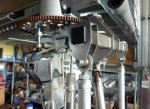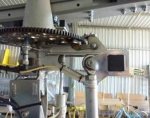I also own a MTOsport but is the older model which does not have the problem.
The first photo is the older model's rotorhead (push pull bar orientated down)and the second is the later model's rotorhead (push pull bar orientated forward). The distinction is the orientation of the push-pull bar, by orientating the bar forward it will allow a longer travel. I guess also the rotorhead back stop must also be adjusted to allow for this extra travel. The photos show that it is easy to distinguish between the types.
I dont think this adds any extra stresses on the control system, although it would mean that the actual vertical rods would have to be longer or the threaded rod ends have to be wound out further, but either way I dont see there is much of a problem there.
However, it does look like it is a deliberate attempt to increase the amount of angle the rotor can be tilted, and the factory will no doubt have reason why they did this, perhaps it improves perfomance.
The issue we have here in Australia by making this change is the machine no longer conforms to Australian standards (or British for that matter). What complicates this is that the change did not correspond to a model change and the new machines have been imported here under the older models certification, when clearly a rotor head change would require new certification (as according to ASRA regs). So ASRA has had to restrict the usage of all MTOsports regardless of what head they have because they have been imported under the same certificate.
This problem would not have occurred if the importer had noted the change when it happened and either got the change certified or ask the factory to only supply the older heads.
ASRA are sympathertic to us MTOSport owners here and trying to sort this out and the last thing that anyone wants is to end up restricting anyone's machine. For those who have an older machine we need to measure the rotor blade clearance from the prop and tail and submit the results and a letter of excemption will be issued to each machine which passes the test.
As for the bit about the chopping of the prop and tail accident which occurred here, there will be much debate about whether it is blade flap, it certainly does sound like the classic blade flap scenario, T & Gs with the last minute decision to do one more circuit powering up and pulling on the stick before checking rotor speed. However, because of the design of the new rotorhead it would only require the blades to slow down to a minumum speed that results in the coning angle to decrease which would be enough to chop the tail if the stick is bought all the way back. This could happen in no wind conditions and the gyro stationary, which is technically not blade flap but simply chopping your tail off. If the blades are kept above a certain rpm then the coning angle will always be great enough to clear the tail and no real danger exists, but then MTOsport pilots will always have to be vigilant about this and dont have momentary brain fart and pull the stick to early or have it slip out your hands when slowing the rotors or something like that and inadvertantly chop your tail. Although the factory does state that the pre-rotator is required equipment for flight, if you ever got stuck away from home base (say the belt broke) it would be a brave man to try and and hand start the rotors if you new that the rotors could come in contact with the tail, especially when considering that you would probably not practice these very often and be pretty rusty at it.


